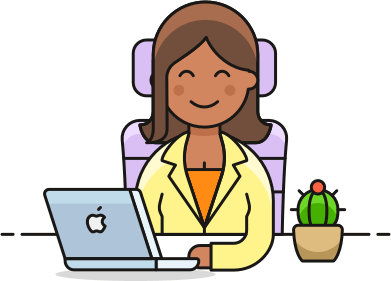Know Your Legal Rights
Whether you’re going for an interview or are currently employed, it is important to know which anti-discrimination laws affect you and your employer.
The ADA National Network Disability Law Handbook – Read the “Employment and the ADA” section to learn what requirements must be met for you to be covered by Title I.
Office of Federal Contract Compliance Programs Disability Rights Fact Sheet – The fact sheet clarifies FAQs such as whether you should disclose your disability when applying for a job, what “reasonable accommodation” means, and more.
Equal Employment Opportunity Commission’s Q&A on Blindness and Vision Impairments in the Workplace – The site provides real world examples to explain the legality of scenarios someone with a vision impairment might encounter when applying for an opening and while on the job. The EEOC also provides a detailed guide explaining reasonable accommodation.

Disability Rights Resources for People with Vision Loss – The American Foundation for the Blind (AFB) provides information and resources on employment and education rights at the federal and state/local levels.
Know Your Rights – Vocational Rehabilitation Services Program – Learn whether you qualify for VR and how to apply for those services.
National Federation of the Blind Assists Federal Employee Experiencing Discrimination – This article provides insight into the kind of discrimination people with vision loss might experience at work and shows how the NFB can assist in these matters.
Use a Template to Create the Perfect Resume
Writing your resume is one of the first steps you’ll take on the road to your new career. It is also how you’ll make your first impression with a potential employer. Getting it right takes time and focus, but thankfully, there are many resources available to help you succeed.
If you’re struggling with starting your resume, templates are a great place to start. A template will provide you with a readymade design, structure, and content. Some are are even tailored to a certain profession.
How to find a template that works for you. Hloom.com provides more than 200 professional resume layout examples. These templates are free to download and come in a variety of designs.
How to use a template. About.com notes that it’s best to use a template as a “starting point.” If you find one with readymade content, be sure to rework it so that it is original and accurately reflects your own experience.
How to make it your own. Even when using a template, you can still make changes to ensure your resume stands out. U.S. News & World Report recommends changing the font or switching up how your experience is listed.
Job Readiness Checklist
Are you ready to start your job hunt, but don’t know exactly how to get going. Follow this readiness checklist to prepare for the ups and downs of launching your career.
Reach out to the Job Accommodation Network (JAN). JAN is a multi-function organization that provides guidance to employers, federal agencies, and people with disabilities.

Participate in a virtual employment workshop. Action for Blind People is a UK organization that addresses the needs of visually impaired people. It offers several videos with employment advice:
- What work gives me
- How I got into work
- The dos and don’ts of applying for a job
- Where to look for work
- Choosing your career
- First impressions in interviews
Find a job. AFB offers several sections of articles which address issues that might come up in your search:
Write a great cover letter. When applying for an opening, you’ll want to send a cover letter with your resume. About.com provides advice to help you create one that will catch a potential employer’s attention:
Prepare for interviews. Few experiences are more nerve-wracking than going on an interview. The Minnesota Department of Employment and Economic Development offers advice specifically for the visually impaired on what to do before, during, and after an interview.
Learn the ins and outs of networking. Sometimes getting a job is all about who you know. If you aren’t familiar with tapping into your network of friends, family, former colleagues, and everyone in between, HelpGuide.org offers tips so that you can hone your skills.
Get Help Paying for College

Many scholarships are available to people with visual impairments who are seeking to continue their education. Here is a listing.
- American Council of the Blind Scholarship Program
- American Federation for the Blind Scholarship Program
- Association of Blind Citizens’ Assistive Technology Fund
- Association for Education and Rehabilitation of the Blind and Visually Impaired Ferrell Scholarship Fund
- Bucknell University’s Marianne E. Szoo Teleky Memorial Scholarship
- California State University Foundation
- Dale M. Schoettler Scholarship for Visually Impaired Students
- Nathaniel R. and Valerie Dumont Scholarship
- Calvin University’s Judith DeJong Clousing Disabilities Scholarship
- Christian Record Services
- Creighton University’s Charles & Mary Patricia Blevens McFadden Endow
- Florida Atlantic University’s Damon Anthony Bettendorf Scholarship
- Georgia Council of the Blind’s Al Camp Memorial Scholarship
- George Washington University’s Barbara Jackman Zuckert Scholarship for Blind Part-time Students
- Indiana University’s Dr. and Mrs. Harold A. Cohen Scholarship
- The Kennedy Center’s Very Special Arts
- Lighthouse Guild Scholarship Program
- National Federation of the Blind Scholarship Program
- National Federation of the Blind of Washington
- Hazel tenBroek Merit Scholarship
- Beverly Prows Memorial Scholarship
- Northern Kentucky University’s Elmer and Blanche Pieper Endowed Scholarship
- Point Loma Nazarene University’s Braille Transcribers Guild Endowed Scholarship
- Stonehill College’s John E. and Aliese Price Foundation Scholarship
- UCLA’s Gordon Hein Memorial Scholarship
- United States Association of Blind Athletes’ Copeland Scholarships
- University of Maryland’s Pegasus Scholarship Fund
- University of Wisconsin-Madison’s Arndt Family Scholarship
- West Texas A&M University’s Carolyn Forrester Lemons Memorial Scholarship
Take Advantage of Career Guidance
Many organizations have been established to provide career guidance to the visually impaired. Here is a collection of those organizations with information on how they can help.
AFB’s CareerConnect – Access employment resources, career exploration tools, and extensive job seeking advice.
National Industries for the Blind – The NIB works to help people with vision loss and impairment achieve personal and economic independence. Through the sale of its products, it, along with its partner agencies, is the number one employer of people who are blind.
American Macular Degeneration Foundation’s Care and Services Directory – Gain access to state agencies that provide employment and other services.
U.S. Office of Personnel Management’s Disability Employment – Learn how to get placed in a Federal government position.
Hire Disability Solutions – This organization leads the way in “enhancing employment opportunities for people with disabilities.
Helen Keller Services for the Blind – HKSB provides employment services and vocational assessment.
Find Your New Job
Ready to start your search? Use one of these resources to find a position in your desired area or field.
AFB’s Job Listings – AFB provides this regularly updated list of opportunities.
ACB’s Job Connection – With this site, ACB offers easy access to vacancy information.
NIB’s Careers with Vision – Find out what opportunities are available under the NIB umbrella.
USA Jobs – Search available positions on the Federal government’s official site.
Getting Hired – This site lists opportunities for individuals and veterans with disabilities.
CareerOneStop – Search by state and take advantage of other resources provided by the Department of Labor.
CareerJet – Use this employment search engine to find opportunities throughout the country and around the world.
ChronicleVitae – Locate openings in higher education.
Monster – Search and apply for jobs using this popular resource.
Monster – Search and apply for jobs using this popular resource.
Indeed – A quick and easy way to find openings in your area.

